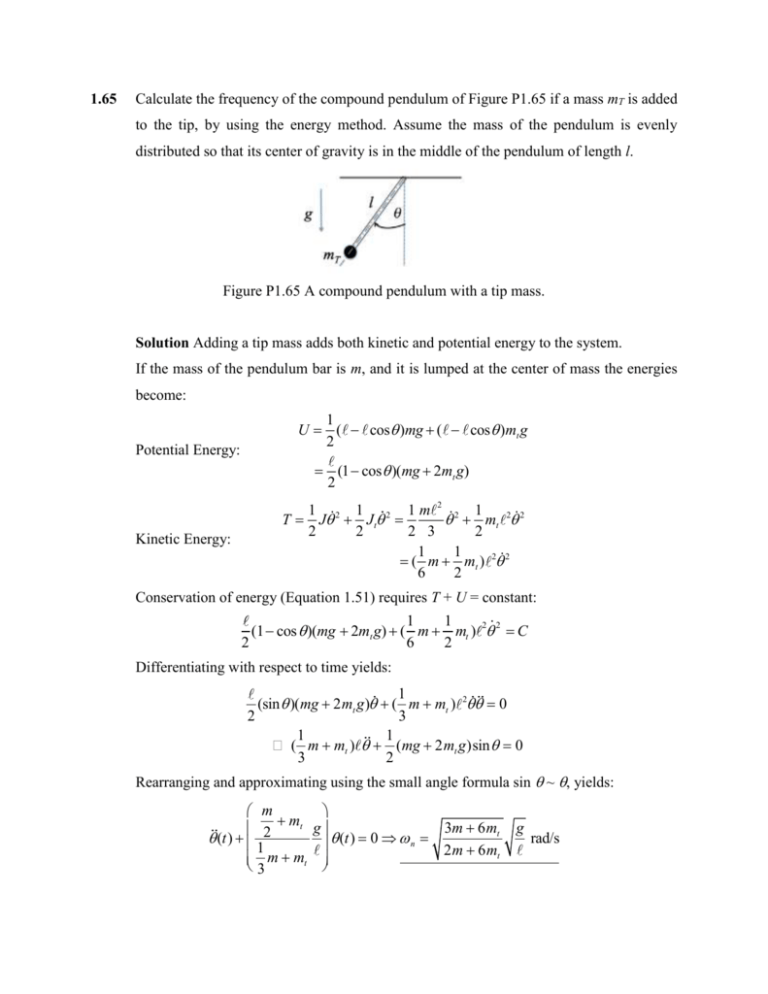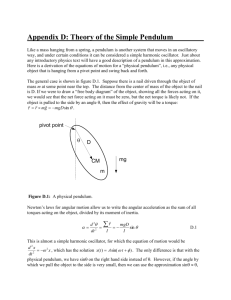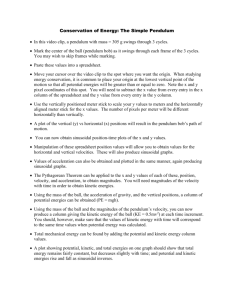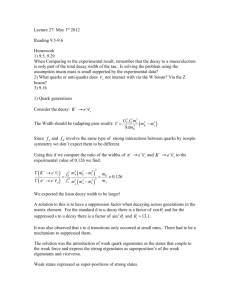1.65 Calculate the frequency of the compound pendulum of Figure
advertisement

1.65 Calculate the frequency of the compound pendulum of Figure P1.65 if a mass mT is added to the tip, by using the energy method. Assume the mass of the pendulum is evenly distributed so that its center of gravity is in the middle of the pendulum of length l. Figure P1.65 A compound pendulum with a tip mass. Solution Adding a tip mass adds both kinetic and potential energy to the system. If the mass of the pendulum bar is m, and it is lumped at the center of mass the energies become: Potential Energy: 1 U = ( - cosq )mg + ( - cosq )mt g 2 = (1- cosq )(mg + 2mt g) 2 T= Kinetic Energy: 1 2 1 2 1m 2 2 1 Jq + Jtq = q + mt 2q 2 2 2 2 3 2 1 1 = ( m + mt ) 2q 2 6 2 Conservation of energy (Equation 1.51) requires T + U = constant: 1 1 (1- cos q )(mg + 2mt g) + ( m + mt ) 2q˙ 2 = C 2 6 2 Differentiating with respect to time yields: 1 (sin q )(mg + 2mt g)q + ( m + mt ) 2qq = 0 2 3 1 1 Þ ( m + mt ) q + (mg + 2mt g)sin q = 0 3 2 Rearranging and approximating using the small angle formula sin ~ , yields: æ m ö + mt g 3m + 6mt ç ÷ q (t) + ç 2 ÷ q (t) = 0 Þ w n = 2m + 6m 1 t çè m + mt ÷ø 3 g rad/s Note that this solution makes sense because if mt = 0 it reduces to the frequency of the pendulum equation for a bar, and if m = 0 it reduces to the frequency of a massless pendulum with only a tip mass. 1.68 Consider the pendulum and spring system of Figure P1.68. Here the mass of the pendulum rod is negligible. Derive the equation of motion using the energy method. Then linearize the system for small angles and determine the natural frequency. The length of the pendulum is l, the tip mass is m, and the spring stiffness is k. Figure P1.68 A simple pendulum connected to a spring Solution: Writing down the kinetic and potential energy yields: 1 1 T = ml 2q 2 , U = kx 2 + mgh 2 2 1 U = kl 2 sin 2 q + mgl(1- cosq ) 2 Here the soring deflects a distance lsin, and the mass drops a distance l(1 –cos). Adding up the total energy and taking its time derivative yields: d æ1 2 2 1 2 2 ml q + kl sin q + mgl cosq ö è ø dt 2 2 = (ml 2q )q + (kl 2 sinq cosq )q - mgl sin qq = 0 Þ ml 2q + kl 2 sin q cosq - mgl sinq = 0 For small , this becomes ml 2q + kl 2q - mglq = 0 kl - mg Þq + q =0 ml Þwn = kl - mg rad/s ml 1.69 A control pedal of an aircraft can be modeled as the single-degree-of-freedom system of Figure P1.69. Consider the lever as a massless shaft and the pedal as a lumped mass at the end of the shaft. Use the energy method to determine the equation of motion in and calculate the natural frequency of the system. Assume the spring to be unstretched at = 0. k l1 l2 m Figure P1.69 Solution: In the figure let the mass at = 0 be the lowest point for potential energy. Then, the height of the mass m is (1-cos)2. Kinematic relation: x = 1 1 2 1 2 2 Kinetic Energy: T = mx˙ = m 2q˙ 2 2 1 2 Potential Energy: U = k( 1q ) + mg 2 (1 - cosq ) 2 Taking the derivative of the total energy yields: d (T +U) = m 22q˙q˙˙ + k( 12q )q˙ + mg 2 (sinq )q˙ = 0 dt Rearranging, dividing by d/dt and approximating sin with yields: 2 ˙˙ m 2q + (k 12 + mg 2 )q = 0 Þwn = k 2 1 + mg m 22 2 1.80 Consider the disk of Figure P1.80 connected to two springs. Use the energy method to calculate the system's natural frequency of oscillation for small angles (t). (t) k k s a x(t) r m mass Figure P1.80 Solution: Known: x = rq , x˙ = r q˙ and J o = Kinetic energy: 1 2 mr 2 1 1 æ mr 2 ö 2 1 2 2 2 Trot = J oq = ç q = mr q 2 2 è 2 ÷ø 4 1 1 Ttrans = mx 2 = mr 2q 2 2 2 1 1 3 T = Trot + Ttrans = mr 2q 2 + mr 2q 2 = mr 2q 2 4 2 4 1 2 2 Potential energy: U = 2 æ k [( a + r )q ] ö = k ( a + r ) q 2 è2 ø Conservation of energy: T + U = Constant d (T + U ) = 0 dt d æ3 2 2 mr q + k ( a + r )2 q 2 ö = 0 è ø dt 4 3 2 2 mr ( 2qq ) + k ( a + r ) ( 2qq ) = 0 4 3 2 2 mr q + 2k ( a + r ) q = 0 2 Natural frequency: k 2k ( a + r )2 w n = eff = 3 2 meff mr 2 wn = 2 a+r k rad/s r 3m 1.111 Consider the system of Figure P1.111. (a) Write the equations of motion in terms of the angle, , the bar makes with the vertical. Assume linear deflections of the springs and linearize the equations of motion. (b) Discuss the stability of the linear system’s solutions in terms of the physical constants, m, k, and . Assume the mass of the rod acts at the center as indicated in the figure. Figure P1.111 Solution: Note that from the geometry, the springs deflect a distance kx = k( sinq ) and the cg is a distance 2 cosq up from the horizontal line through point 0 taken as zero gravitational potential. Thus the total potential energy is 1 mg U = 2 ´ k( sin q )2 + cosq 2 2 Using the inertia for a thin rod of length l rotating about its end, the total kinetic energy is 1 1m 2 2 T = J Oq 2 = q 2 2 3 The Lagrange equation (1.64) becomes d æ ¶T ö ¶U d æ m 2 ö 1 + = q + 2k sin q cos q mg sin q = 0 ç ÷ dt çè ¶q ÷ø ¶q dt è 3 ø 2 Using the linear, small angle approximations sinq » q and cosq » 1 yields æ m 2 mg ö a) q + ç 2k 2 q=0 3 2 ÷ø è Since the leading coefficient is positive the sign of the coefficient of determines the stability. if 4k - mg > 0 Þ 4k > mg Þ the system is stable b) if 4k = mg Þ q (t) = at + b Þ the system is unstable if 4k - mg < 0 Þ 4k < mg Þ the system is unstable Note that physically these results state that the system’s response is stable as long as the spring stiffness is large enough to overcome the force of gravity.








